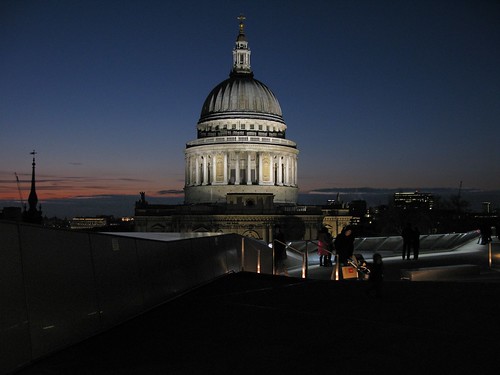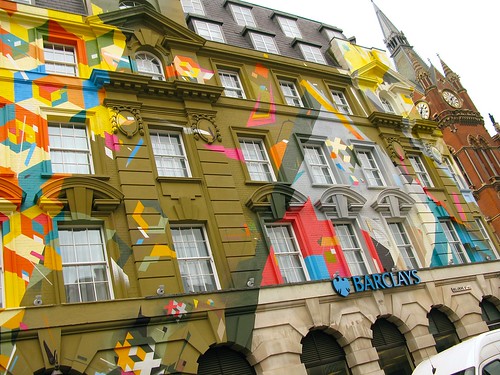The huge all-glass hulk that is 1 New Change, round the back of St Paul's Cathedral, is not everyone's idea of how London should be developed. It's big and bland, almost completely featureless except for some shading patterns printed on the glass and some wacky angles, like giant crystals dumped opposite St Paul's churchyard. It has a certain something, but that something works only because of the architectural interest that surrounds it. At least, though, the new public roof terrace offers some amazing views over the city, previously inaccessible and completely free.
What developers love to do, is to take a whole city block if possible, where there might have been twenty or thirty buildings all constructed individually, each with its own character and not quite the same as its neighbours, sometimes not even similar in height and style - and fill the whole block with a single building, usually much higher than what was there before. The developers will talk about financial reality, about ensuring they get enough sellable units or enough square feet of retail space to make the project financially viable. In fact, London woud be a bit of a grim place if we had nothing but street after street of unchanged Victorian buildings. The big set pieces do contribute something, opening up the street pattern and making London a contemporary city, not a historical set-piece. Even so, the pressure for large projects is insidious.
Construction projects are a huge part of the country's economy, so that lends pressure to the introverted logic of those profitability arguments, which seem to be taken at face value by everyone concerned whatever the merits of the project. Step outside of that mindset, though, and you see a process that isn't always creating change for the better. Imagine, as the developers do, that eventually all but the best listed buildings, everything except the heritage centrepieces, will eventually present an opportunity to cash in, and you can see how London might be edging towards a completely different look, a city of giant developments with the odd quaint old building dwarfed between them to amuse the tourists. Does that sound familiar?
1 New Change was designed for Land Securities by French architect Jean Nouvel. The shaded glass idea seems to be borrowed from an even uglier building in Manhattan by Frank Gehry. Nouvel's 23-storey residential tower at 100 11th Avenue is a straightforward vertical block with one curved side and a rather pleasing façade of random square windows. It sits side by side with Gehry's building and completely outshines it, which makes it ironic that St Paul's got a design influenced in that way.
Friday, 25 May 2012
Friday, 11 May 2012
Colour explosion at Kings Cross
This splash of colour is what used to be the worthy but dull Kings Cross branch of Barclays Bank. As a matter of fact the bank is still there, but the rest of the building is a newish fashionable hotel, the Megaro, with interior designed rooms at more than 200 quid a night. At first sight it's quite striking, but a splash of colour is all it is, there's nothing very inspired about the design, and it completely muddles the architectural language of the building. It's not illegal (although it's in a conservation area no planning permission was required) but you could say it's short-sighted, not really worth the permanent damage.
The hotel is a typical London block, built in the early twentieth century in red brick with lots of fine carved limestone details, nothing very exciting by London standards, but just try looking for that kind of thing in an American city, for example. That paint is guaranteed for twenty years, apparently, but the novelty is going to wear off much sooner than that. Will it come off? No, most unlikely: even intensive graffiti removal techniques don't entirely remove all the paint, and over an entire building that would be ridiculously expensive. Sandblasting might work but it destroys the surface of bricks. So the original natural materials are likely to be covered up permanently.
One can only hope the owners will keep the facades freshly painted, and maybe next time do something that actually makes use of the architecture instead of camouflaging it.
The hotel is a typical London block, built in the early twentieth century in red brick with lots of fine carved limestone details, nothing very exciting by London standards, but just try looking for that kind of thing in an American city, for example. That paint is guaranteed for twenty years, apparently, but the novelty is going to wear off much sooner than that. Will it come off? No, most unlikely: even intensive graffiti removal techniques don't entirely remove all the paint, and over an entire building that would be ridiculously expensive. Sandblasting might work but it destroys the surface of bricks. So the original natural materials are likely to be covered up permanently.
One can only hope the owners will keep the facades freshly painted, and maybe next time do something that actually makes use of the architecture instead of camouflaging it.
Subscribe to:
Posts (Atom)


